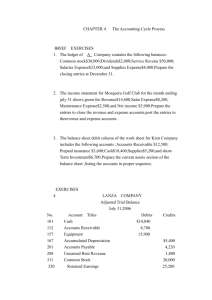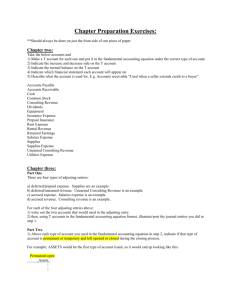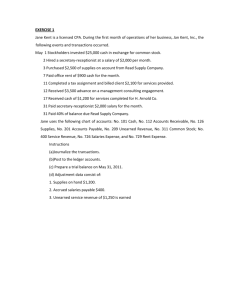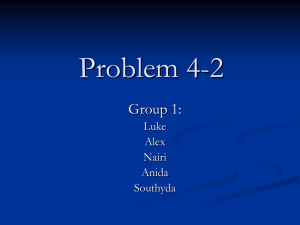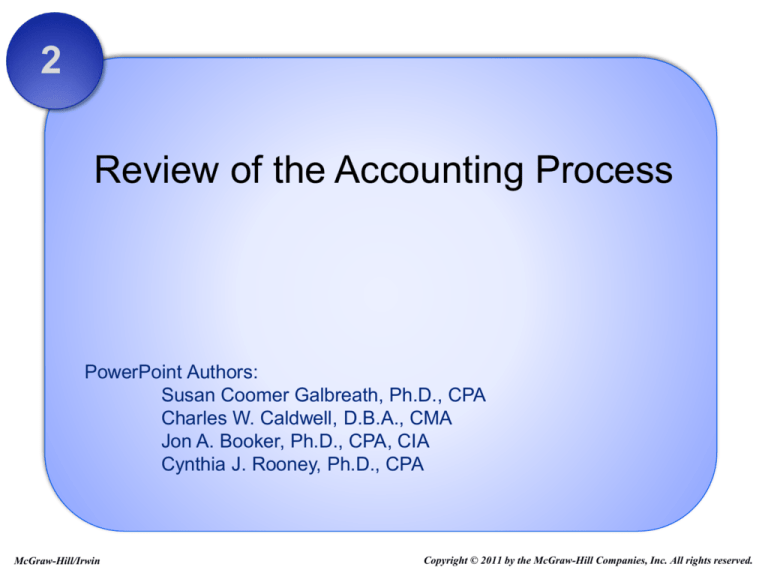
2
Review of the Accounting Process
PowerPoint Authors:
Susan Coomer Galbreath, Ph.D., CPA
Charles W. Caldwell, D.B.A., CMA
Jon A. Booker, Ph.D., CPA, CIA
Cynthia J. Rooney, Ph.D., CPA
McGraw-Hill/Irwin
Copyright © 2011 by the McGraw-Hill Companies, Inc. All rights reserved.
The Accounting Equation
A = L + OE
+ Owner Investments
2-2
- Owner Withdrawals
+ Revenues
+ Gains
- Expenses
- Losses
Accounting Equation for a Corporation
A = L + SE
+ Paid-in Capital
+ Retained Earnings
+ Revenues - Expenses - Dividends
+ Gains
- Losses
2-3
Accounting Equation, Debits and
Credits, Increases and Decreases
Permanent Accounts—assets, liabilities, paid-in capital, retained earnings
Temporary Accounts-revenues, gains, expenses, losses
2-4
During the Accounting Period
Source
documents
Transaction
Analysis
Record in
Journal
Post to
Ledger
At the End of the Accounting Period
Financial
Statements
Adjusted
Trial Balance
Record & Post
Adjusting
Entries
At the End
of the Year
Close Temporary
Accounts
2-5
Post-Closing
Trial Balance
Unadjusted
Trial Balance
The
Accounting
Processing
Cycle
The Accounting Processing Cycle
On July 1, two individuals each invested $30,000 in a new
business, Dress Right Clothing Corporation. Each
investor was issued 3,000 shares of common stock.
Two accounts are affected:
Cash (an asset) increases by $60,000.
Common stock (a shareholders’ equity) increases
by $60,000.
July 1
Cash
Common stock
2-6
60,000
60,000
General Ledger
GENERAL LEDGER
Account:
Acct. No.
##
Balance
Date
Item
Post.
Ref.
Debit
Credit
DR (CR)
The “T” account is a shorthand format of an account
used by accountants to analyze transactions.
It is not part of the bookkeeping system.
2-7
Posting Journal Entries
2-8
After recording all entries for the period, Dress Right’s
Unadjusted Trial Balance would be as follows:
Dress Right Clothing Corporation
Unadjusted Trial Balance
July 31, 2011
Account Title
Cash
Accounts receivable
Supplies
Prepaid rent
Inventory
Furniture and fixtures
Accounts payable
Notes payable
Unearned rent revenue
Common stock
Retained earnings
Sales revenue
Cost of goods sold
Salaries expense
Total
2-9
Debits
$
68,500
2,000
2,000
24,000
38,000
12,000
Credits
$
35,000
40,000
1,000
60,000
A Trial
Balance is a
list of all
accounts
and their
balances at
a particular
date.
1,000
38,500
22,000
5,000
$ 174,500
$ 174,500
Debits = Credits
Adjusting Entries
At the end of the period, adjusting entries are
required to satisfy the realization principle and
the matching principle.
Prepayments
Accruals
Estimates
Transactions where
cash is paid or received
before a related
expense or revenue is
recognized.
Transactions where
cash is paid or received
after a related expense
or revenue is
recognized.
Accountants must often
make estimates in order
to comply with the
accrual accounting
model.
2 - 10
Prepaid Expenses
Expense
Asset
Unadjusted
Balance
Credit
Adjustment
Debit
Adjustment
Today, I will pay
for my first
6 months’ rent.
Prepaid Expenses
Items paid for in advance
of receiving their benefits
2 - 11
Depreciation
Depreciation is the process of allocating the cost
of plant and equipment over their expected
useful lives.
Straight-Line
Depreciation
2 - 12
Asset Cost - Salvage Value
=
Useful Life
Depreciation
Recall the Furniture and Fixtures for $12,000 listed on
Dress Right’s unadjusted trial balance. Assume the
following:
Asset Cost
$ 12,000
Salvage Value
Useful Life
60 months
Let’s calculate the depreciation expense for the month
ended July 31, 2011.
2 - 13
Depreciation
Recall the Furniture and Fixtures for $12,000 listed on
Dress Right’s unadjusted trial balance.
Asset Cost
$ 12,000
Salvage Value
Useful Life
60 months
July
Depreciation
Expense
$12,000 - $0
=
=
$200 per month
60 months
July 31
Depreciation expense
200
Accumulated depreciationfurniture and fixtures
200
2 - 14
Depreciation
After posting, the accounts look like this:
Furniture and Fixtures
Beg. bal.
12,000
Bal.
12,000
Depreciation Expense
Beg. bal.
200
Bal.
200
Accumulated Depreciation
Beg. bal.
200
200 Bal.
2 - 15
Unearned Revenues
Liability
Debit
Adjustment
Unadjusted
Balance
Buy your season tickets for
all home basketball games NOW!
“Go Big Red”
2 - 16
Revenue
Credit
Adjustment
Unearned Revenue
Cash received in
advance of performing
services
Alternative Approach to Record
Prepayments
Prepaid Expenses
Record initial cash
payments as follows:
Expense
Cash
2 - 17
$$$
$$$
Unearned Revenue
Record initial cash
receipts as follows:
Cash
$$$
Revenue
$$$
Adjusting Entry
Record the amount for
the prepaid expense as
follows:
Adjusting Entry
Record the amount for the
unearned liability as
follows:
Prepaid expense $$$
Expense
$$$
Revenue
$$$
Unearned revenue $$$
Accrued Liabilities
Expense
Debit
Adjustment
I won’t pay you
until the job is done!
2 - 18
Liability
Credit
Adjustment
Accrued Liabilities
Liabilities recorded when an
expense has been incurred
prior to cash payment.
Accrued Receivables
Asset
Debit
Adjustment
Yes, you can pay me
in May for your April
15 tax return.
2 - 19
Revenue
Credit
Adjustment
Accrued Receivables
Revenue earned in a
period prior to the cash
receipt.
Estimates
Accountants often must make estimates of
future events to comply with the accrual
accounting model.
• Examples
– Depreciation
– Uncollectible accounts
$
2 - 20
Estimates
Assume that Dress Right’s management
determines that of the $2,000 of accounts
receivable recorded at July 31, only $1,500 will
ultimately be collected. Prepare the adjusting
entry for July 31.
July 31
Bad debt expense
Allowance for uncollectible
accounts
2 - 21
500
500
DRESS RIGHT CLOTHING CORPORATION
Adjusted Trial Balance
July 31, 2011
Account Title
Debits
Credits
Cash
$ 68,500
Accounts receivable
2,000
Allowance for uncollectible accounts
$
500
Supplies
1,200
Prepaid rent
22,000
Inventory
38,000
Furniture and fixtures
12,000
Accumulated depr.-furniture & fixtures
200
Accounts payable
35,000
Note payable
40,000
Unearned rent revenue
750
Salaries payable
5,500
Interest payable
333
Common stock
60,000
Retained earnings
1,000
Sales revenue
38,500
Rent revenue
250
Cost of goods sold
22,000
Salaries expense
10,500
Supplies expense
800
Rent expense
2,000
Depreciation expense
200
Interest expense
333
Bad debt expense
500
Totals
$ 181,033 $ 181,033
2 - 22
This is the Adjusted
Trial Balance for
Dress Right after all
adjusting entries have
been recorded and
posted.
Dress Right will use
these balances to
prepare the financial
statements.
The
Income Statement
Dress Right Clothing Corporation
Income Statement
For Month Ended July 31, 2011
Sales revenue
Cost of goods sold
Gross profit
Other expenses:
Salaries
$
Supplies
Rent
Depreciation
Bad debt
Total operating expenses
Operating income
Other income (expense):
Rent revenue
Interest expense
Net income
$
38,500
22,000
16,500
10,500
800
2,000
200
500
14,000
2,500
250
(333)
$
(83)
2,417
The income statement summarizes the results
of profit-generating activities of the company.
2 - 23
TheDressBalance
Sheet
Right Clothing Corporation
Balance Sheet
At July 31, 2011
Assets
Current assets:
Cash
Accounts receivable
Less: Allowance for uncollectible accounts
Supplies
Inventory
Prepaid rent
Total current assets
Property and equipment:
Furniture and fixtures
Less: Accumulated depreciation
Total assets
$
$
2,000
500
68,500
1,500
1,200
38,000
22,000
131,200
12,000
200
$
11,800
143,000
The balance sheet presents the financial
position of the company on a particular date.
2 - 24
TheDressBalance
Sheet
Right Clothing Corporation
Balance Sheet
At July 31, 2011
Liabilities and Shareholders' Equity
Current liabilities:
Accounts payable
Salaries payable
Unearned rent revenue
Interest payable
Note payable
Total current liabilities
Long-term liabilities:
Note payable
Shareholders' equity:
Common stock
Retained earnings
Total shareholders' equity
Total liabilities and shareholders' equity
$
35,000
5,500
750
333
10,000
51,583
30,000
$
60,000
1,417
$
61,417
143,000
Notice that assets of $143,000 equals total
liabilities plus shareholders’ equity of $143,000.
2 - 25
The Statement of Cash Flows
Dress Right Clothing Corporation
Statement of Cash Flows
For the Month of July 2011
Cash flows from Operating Activities:
Cash inflows:
From customers
From rent
Cash outflows:
For rent
For supplies
To suppliers for merchandise
To employees
Net cash used by operating activities
Cash flows from Investing Activities:
Purchase of furniture and fixtures
Cash flows from Financing Activities:
Issue of capital stock
Increase in notes payable
Payment of cash dividend
Net cash provided by financing activities
Net increase in cash
$
36,500
1,000
(24,000)
(2,000)
(25,000)
(5,000)
$ (18,500)
(12,000)
$
60,000
40,000
(1,000)
$
99,000
68,500
The statement of cash flows discloses the
changes in cash during a period.
2 - 26
The Statement of Shareholders’ Equity
Dress Right Clothing Corporation
Statement of Shareholders' Equity
For the Month of July 2011
Balance at July 1, 2011
Issue of capital stock
Net income for July 2011
Less: Dividends
Balance at July 31, 2011
Total
Common
Retained Shareholders'
Stock
Earnings
Equity
$
$
$
60,000
60,000
2,417
2,417
(1,000)
(1,000)
$
60,000 $
1,417 $
61,417
The statement of shareholders’ equity
presents the changes in permanent
shareholder accounts.
2 - 27
The Closing Process
Income
Summary
2 - 28
Liabilities
Permanent
Accounts
Shareholders’
Equity
Temporary
Accounts
Assets
Dividends
Expenses
Revenues
The closing process applies
only to temporary accounts.
Post-Closing Trial Balance
DRESS RIGHT CLOTHING CORPORATION
Post-Closing Trial Balance
July 31, 2011
Account Title
Debits
Credits
Cash
$ 68,500
Accounts receivable
2,000
Allowance for uncollectible accounts
$
500
Supplies
1,200
Prepaid rent
22,000
Inventory
38,000
Furniture and fixtures
12,000
Accumulated depr.-furniture & fixtures
200
Accounts payable
35,000
Note payable
40,000
Unearned rent revenue
750
Salaries payable
5,500
Interest payable
333
Common stock
60,000
Retained earnings
1,417
Totals
$ 143,700 $ 143,700
2 - 29
Lists permanent
accounts and their
balances.
Total debits equal
total credits.
Conversion From Cash Basis to
Accrual Basis
2 - 30
Increases
Decreases
Assets
Add
Deduct
Liabilities
Deduct
Add
Appendix 2A: Use of a Worksheet
A worksheet can be used as a tool to facilitate the
preparation of adjusting and closing entries and the
financial statements.
Steps to Follow for Worksheet Completion:
1.
Enter account titles in column A and the unadjusted account balances in columns
B and C.
2.
Determine end-of-period adjusting entries and enter them in columns E and G.
3.
Add or deduct the effects of the adjusting entries on the account balances and
enter in columns H and I.
4.
Transfer the temporary retained earnings account balances to columns J and K.
5.
Transfer the balances in the permanent accounts to columns L and M.
Let’s look at the completed worksheet for Dress Right.
2 - 31
A
B
C
D
E
F
G
Worksheet, Dress Right Clothing Corporation, July 2011
Unadjusted Trial
Balance
Adjusting Entries
Account Title
Dr.
Cr.
Dr.
Cr.
Cash
68,500
Accounts receivable
2,000
Allowance for
uncollectible accounts
(7)
500
Supplies
2,000
(1)
800
Prepaid rent
24,000
(2)
2,000
Inventory
38,000
Furniture and fixtures
12,000
Accumulated depr.furniture & fixtures
(3)
200
Accounts payable
35,000
Note payable
40,000
Unearned rent revenue
1,000 (4)
250
Salaries payable
(5)
5,500
Interest payable
(6)
333
Common stock
60,000
Retained earnings
1,000
Sales revenue
38,500
Rent revenue
(4)
250
Cost of goods sold
22,000
Salaries expense
5,000
(5)
5,500
Supplies expense
(1)
800
Rent expense
(2)
2,000
Depreciation expense
(3)
200
Interest expense
(6)
333
Bad debt expense
(7)
500
Totals
174,500
174,500
9,583
9,583
Net income
Totals
2 - 32
H
I
J
Adjusted Trial Balance
Dr.
Cr.
68,500
2,000
K
Income Statement
Dr.
Cr.
L
M
Balance Sheet
Dr.
Cr.
68,500
2,000
500
500
1,200
22,000
38,000
12,000
1,200
22,000
38,000
12,000
200
35,000
40,000
750
5,500
333
60,000
200
35,000
40,000
750
5,500
333
60,000
1,000
1,000
38,500
250
22,000
10,500
800
2,000
200
333
500
181,033
38,500
250
22,000
10,500
800
2,000
200
333
500
181,033
2,417
38,750
38,750
144,700
2,417
144,700
Appendix 2B: Reversing Entries
Reversing entries remove the effects of some of
the adjusting entries made at the end of the
previous reporting period for the sole purpose of
simplifying journal entries made during the new
period. Reversing entries are optional and are
used most often with accruals.
2 - 33
Appendix 2C: Subsidiary Ledgers
Subsidiary ledgers contain a group of subsidiary
accounts associated with particular general ledger
control accounts. Subsidiary ledgers are commonly
used for accounts receivable, accounts payable,
plant and equipment, and investments.
For example, there will be a subsidiary ledger for
accounts receivable that keeps track of the increases
and decreases in the accounts receivable balance
for each of the company’s customers purchasing
goods and services on credit.
After all of the postings are made from the appropriate journals, the balance
in the accounts receivable control account should equal the sum of the
balances in the accounts receivable subsidiary ledger accounts.
2 - 34
Appendix 2C: Special Journals
Special journals are used to capture the dual
effect of repetitive types of transactions in
debit/credit form.
Special journals simplify the recording process in the following ways:
1.
Journalizing the effects of a particular transaction is made more efficient
through the use of specifically designed formats.
2.
Individual transactions are not posted to the general ledger accounts but are
accumulated in the special journals and a summary posting is made on a
periodic basis.
3.
The responsibility for recording journal entries for the repetitive types of
transactions is placed on individuals who have specialized training in handling
them.
2 - 35
Sales Journal
Sales journals record all credit sales. Every
entry in the sales journal has the same effect
on the accounts; the sales revenue account
is credited and the accounts receivable
control account is debited.
SALES JOURNAL
Page 1
Cr. Sales
Revenue
(400)
Dr. Accounts
Receivable
(110)
Accounts
Receivable
Subsidiary
Account No.
Customer Name
Sales
Invoice
Number
5
801
Leland High School
10-221
1,500
9
812
Mr. John Smith
10-222
200
18
813
Greystone School
10-223
825
22
803
Ms. Barbara Jones
10-224
120
29
805
Hart Middle School
10-225
650
Date
2011
Aug.
3,295
2 - 36
Other
columns
capture
information
needed for
updating the
accounts
receivable
subsidiary
ledger.
Cash Receipts Journal
Cash receipts journals record all cash
receipts, regardless of the source. Every
entry in the cash receipts journal produces a
debit to the cash account with the credit to
various other accounts.
CASH RECEIPTS JOURNAL
Date
Explanation or
Account Name
Dr. Cash
(100)
Cr.
Accounts
Receivable
(110)
Page 1
Cr.
Sales
Revenue
(400)
Cr.
Other
Other
Accounts
10,000
Notes
payable
(220)
2011
Aug.
7 Cash sale
11 Borrowed cash
500
10,000
17 Leland High School
750
20 Cash sale
300
25 Mr. John Smith
200
11,750
2 - 37
500
750
300
200
950
800
10,000
End of Chapter 2
2 - 38





